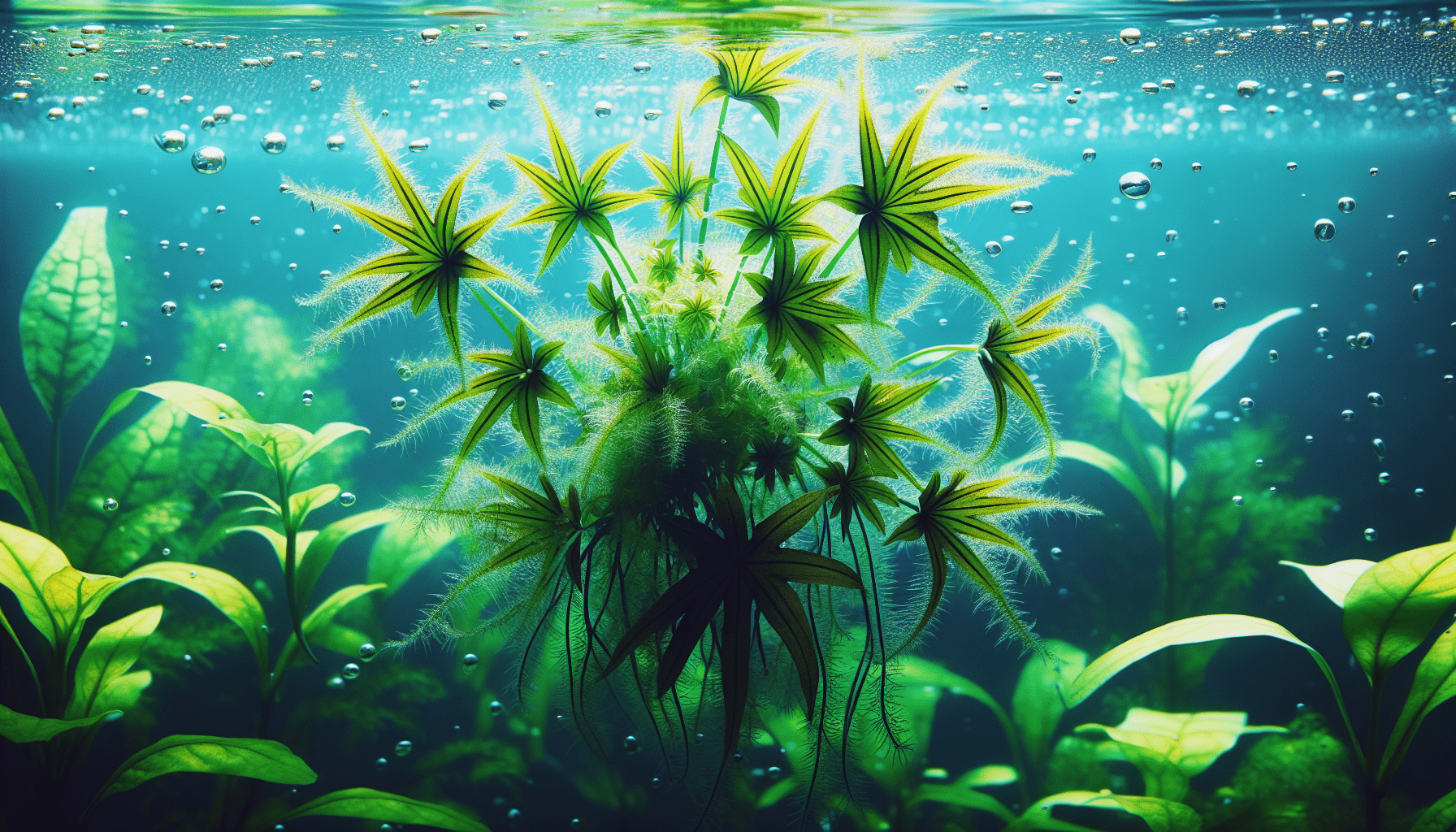You stand at the edge of a pond, squinting at the meshwork of delicate, star-shaped leaves floating on the water surface, wondering what this resilient vegetation might be. The curious aquatic plant distribution has caught your attention, beckoning you to investigate further. This article is an excursion into the world of a specific aquatic weed, the Callitriche Marginata – a plant that thrives in the serene waters of ponds and does more than just adding to the visual aesthetics of the water-body. Over the next several sections, you will journey to delve into the intriguing botanical details of this often-misunderstood plant species, learning about its characteristics, habitat, propagation, nutritional benefits, while simultaneously recognizing and appreciating the ecosystem’s complexity.

Definition of Callitriche Marginata
Callitriche marginata, otherwise recognized as an aquatic weed or water starwort, is a perennial herb indigenous in nature. Subaqueous and terrestrial environments serve as ideal biomes for this aquatic weed, and it exhibits a considerable level of adaptability. The name ‘Callitriche’ has Greek roots and translates to ‘beautiful hair’—eluding to its elongated, fine-textured leaves.
Characteristics of Callitriche Marginata
Callitriche Marginata is characterized by a unique feature—its uncanny ability to adapt. The aquatic weed thrives both submerged in water and on surface terrains, primarily near ponds or stagnant water bodies. Its stems, thin and narrow, stretch out to a full length of 5-35 cm. Furthermore, the plant’s leaves are small and less than 8mm long. The genus Callitriche consists of several species, and Callitriche marginata stands apart through its high morphological variability.
Scientific classification
From a scientific perspective and taxonomy, Callitriche marginata falls under the Plantae kingdom. It is part of the Callitrichaceae family but was initially classified under Plantaginaceae. Its order is categorized as Callitrichales.
Origins and naming of the species
As for the origins of the species, Callitriche marginata can be traced back to North America. The name Callitriche is derived from two Greek phrases: ‘Kallos,’ meaning beauty, and ‘trix,’ referring to hair—a poignant testament to the plant’s beautiful, hair-like leaves. Marginata, on the other hand, is a Latin term for ‘margin,’ indicating the species’ water margin habitat.
Habitat and distribution
Natural distribution around the world
Callitriche marginata is ubiquitous around the globe, demonstrating an impressive ability to adapt to a variety of climates. While the aquatic weed is native to North America, it is widely spread across Europe, the Mediterranean, Southwest Asia, Australia, and New Zealand.
Introduction into new areas
Introduction into new areas occurs primarily through water currents or adherence to waterfowl. In several instances, Callitriche marginata has been introduced artificially into new habitats for the purpose of promoting biodiversity or ecological restoration.
Preferred habitats and growth conditions
The optimal growth conditions for Callitriche marginata encompass fresh and somewhat alkaline bodies of water. The aquatic weed can adapt to acidic conditions but thrives best in water bodies with a pH ranging between 7.0 and 8.5. Wet soil, marshlands, swamps, bogs, and even temporary puddles are adequate environments for this plant.
Physical Description
Root and stem structure
The root system of Callitriche marginata is delicate and minimal, contributing to its alluring hair-like aesthetic. The stems, on the other hand, are thin yet robust, ranging from 5 to 35 cm in length.
Leaf structure and appearance
Callitriche marginata leaves are slender, small, and elliptical, exuding an unparalleled charm. Along the leaf margin, there may be an abundance of tiny red spots, particularly on submerged leaves.
Flower and seed description
The flowers of the Callitriche marginata are minuscule, almost imperceptible to the naked eye. They are generally self-pollinating and yield small, inconspicuous greenish-white fruits.
Life Cycle of Callitriche Marginata
Seasonal growth patterns
The growth period of Callitriche marginata ranges from spring to early autumn. In winters, the aquatic weed goes dormant in response to frost and icy conditions. Come spring, it regenerates with a renewed sense of vigor.
Reproduction and propagation methods
Reproduction transpires through two primary modes—seeds and vegetative propagation. The plant is monoecious, allowing it to self-pollinate and create a myriad of seeds, which are then dispersed by water currents. Vegetative propagation, on the other hand, occurs when fragments of the plant sever from the main body, float away, and establish themselves in new areas.
Lifespan and stages of growth
Callitriche marginata experiences a total lifespan of 2-5 years on average. The stages of development are largely influenced by the environment. From germinating as seeds in the spring, the plants swiftly shift to a stage of intense growth and reproduction in the summer, followed by dormancy in the winter months.

Ecological Role
Benefits to aquatic ecosystems
Callitriche marginata offers a plethora of advantages to aquatic ecosystems. Some animals utilize the plant as a source of food or as breeding grounds. The dense mats formed by the plant serve as a habitat for a number of aquatic organisms. Furthermore, it aids in improving overall water quality by absorbing excessive nutrients.
Interactions with other species
Positive interactions between Callitriche marginata and other species are abundant. Aquatic invertebrates, waterfowl, and fish directly or indirectly rely on the plant. For instance, it serves as a refuge for aquatic creatures and fodder for herbivorous waterfowl.
Potential threats and conservation status
Regrettably, the habitats of Callitriche marginata are increasingly threatened by human activities such as dredging, water drainage, pollution, and other damaging changes in land use. Although common occurrences in many parts of the world, certain varieties are considered endangered and even extinct in some regions.
Human Uses
Historical uses around the world
Historically, Callitriche marginata was utilized for various purposes in different parts of the world. Native Americans consumed certain species of Callitriche as vegetables.
Culinary uses
In the culinary world, various Callitriche species, including marginata, have been used to craft a salad of sorts. The weed’s leaves are comparable to watercress when used in such a manner.
Medical and pharmaceutical uses
Callitriche has also been used in traditional medicine. It is believed to have diuretic properties, and extracts were used in remedies for ailments such as fever and scurvy.
Concerns and Controversies
Invasive potential
Despite its various benefits, the rapid growth and adaptive nature of Callitriche marginata sometimes brings about negative consequences. It can grow invasively and degrade the quality of bodies of water, posing challenges to aquatic life.
Impacts on human activities
Uncontrolled growth can impede recreational activities on water bodies—it extends across the surface of the water, interfering with navigation, fishing, and boating.
Current management strategies
Management strategies often resort to controlling the proliferation of Callitriche marginata without causing collateral damage to local fauna. These strategies can range from manual removal to the utilization of specific herbicides.
Cultivation and Care
Ideal cultivation conditions
The ideal conditions for cultivating Callitriche marginata involve direct sun to partial shade, cool to moderate temperatures, and a moist or well-drained fertile soil. It thrives in fresh, still, or flowing water bodies and grows just as efficiently on a wet ground, displaying its adaptive nature.
Propagation techniques
Propagation occurs through seeds or vegetative cutting. The former involves sowing fresh seeds under the surface of moist soil, while the latter involves planting a cutting with nodes directly on moist ground.
Common diseases and pests
Being an aquatic weed, Callitriche marginata is considerably disease-resistant. The plant’s primary threat comes from invasive insects, such as aphids, which can drain plants of their vital fluids.
Pruning and maintenance requirements
Pruning, performed regularly, is essential for the maintenance of a healthy size as it is for the plant’s appearance. It prevents this aquatic weed from growing invasively and taking over its surroundings.
Genetics and Propagation
Genetic diversity within the species
Despite being a single species, Callitriche marginata boasts an ample amount of genetic diversity—owing to its wide geographic distribution and the variability of its natural habitats. This diversity ultimately contributes to the plant’s renowned adaptability.
Cross-species hybridization potential
Research has revealed limited possibilities of hybridization within the Callitriche genus. Consequently, the likelihood of Callitriche marginata crossbreeding with other species is relatively minimal.
Seeds and vegetative propagation methods
As mentioned before, the plant can reproduce via seeds or vegetative propagation—owing to its characteristic monoecious nature and the resilience of its fragments respectively.
Research and studies
Impact on water quality and ecosystem health
Callitriche marginata reinforces its ecological significance by performing a key function in maintaining the health of aquatic ecosystems. By absorbing excessive nutrients, the plant optimizes water quality and creates an environment conducive to a variety of aquatic organisms.
Effects of climate change on distribution and survival
The effects of climate change on Callitriche marginata remains an area of active research. Predictions suggest that global warming might detrimentally impact the distribution and survival of this species.
Current research and knowledge gaps
Research is ongoing concerning the potentials and limitations of Callitriche marginata, as numerous aspects of its biology, distribution, habitat preferences, and ecological contributions warrant further investigation. The filling of these knowledge gaps would undeniably augment our understanding of this fascinating species.